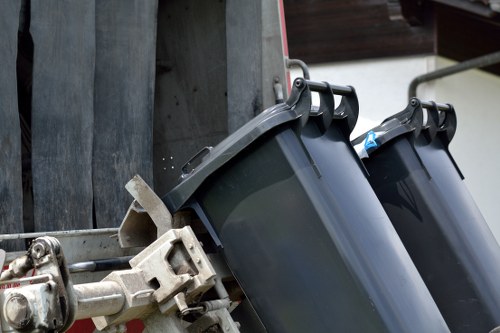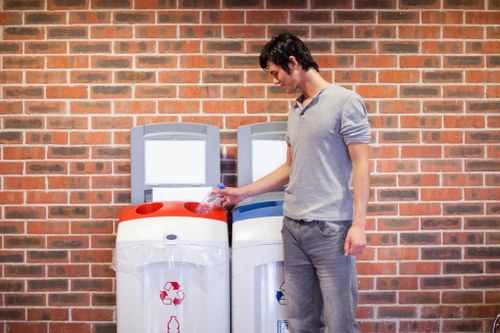Comprehensive Guide to Construction Waste Clearance in Coney Hall

Understanding Construction Waste Clearance
Construction waste clearance is a critical aspect of any building or renovation project. It involves the removal and proper disposal of materials that are no longer needed, ensuring a clean and safe working environment. In Coney Hall, effective waste management is essential due to the area's ongoing development and residential activities.
Proper waste clearance not only helps in maintaining the aesthetic appeal of the area but also plays a significant role in environmental conservation. By efficiently managing construction waste, we can reduce the negative impact on the environment and promote sustainable building practices.
In this article, we will delve into the various aspects of construction waste clearance in Coney Hall, including the types of waste, the clearance process, benefits, and best practices to ensure efficient management.

The Importance of Construction Waste Clearance
Construction projects generate a substantial amount of waste, ranging from concrete and wood to metals and plastics. Without proper clearance, this waste can lead to several issues:
- Environmental Impact: Improper disposal can result in pollution and harm to local ecosystems.
- Health Hazards: Accumulated waste can attract pests and create unsafe conditions for workers and residents.
- Legal Consequences: Non-compliance with waste disposal regulations can lead to fines and legal action.
Therefore, prioritizing waste clearance is not just a matter of cleanliness, but also of legal compliance and environmental stewardship.

Types of Construction Waste
Understanding the types of waste generated during construction is crucial for effective clearance. Common types include:
- Concrete and Masonry: These materials are often leftover from demolition and construction.
- Wood and Timber: Used in framing and other structural elements.
- Metals: Including steel, aluminum, and copper, which can often be recycled.
- Plastics and Polymers: Used in various construction applications.
- Hazardous Waste: Such as asbestos, lead-based paints, and chemicals, requiring specialized handling.
Each type of waste may require different handling and disposal methods to ensure safety and compliance.

The Construction Waste Clearance Process
1. Assessment and Planning
The first step in waste clearance is assessing the amount and type of waste generated. This involves:
- Conducting a site survey to identify all waste materials.
- Categorizing waste based on type and disposal requirements.
- Developing a clearance plan that outlines the methods and schedules for waste removal.
2. Collection and Separation
Once assessed, waste needs to be collected and separated accordingly. Proper separation facilitates recycling and ensures that hazardous materials are handled safely.
3. Transportation
After separation, waste is transported to appropriate disposal or recycling facilities. It's essential to use licensed and reputable waste management services to ensure compliance with local regulations.
4. Disposal and Recycling
Finally, waste is either disposed of in designated landfills or recycled. Recycling helps in reducing the environmental footprint and promotes the reuse of valuable materials.

Benefits of Effective Waste Clearance
Implementing a robust construction waste clearance system offers numerous benefits:
- Environmental Protection: Reduces pollution and conserves natural resources through recycling.
- Cost Savings: Efficient waste management can lower disposal costs and potentially generate revenue from recyclable materials.
- Regulatory Compliance: Ensures adherence to local waste disposal laws, avoiding fines and legal issues.
- Improved Safety: Minimizes hazards on construction sites, promoting a safer working environment.
- Enhanced Reputation: Demonstrates a commitment to sustainability, which can enhance the reputation of construction firms.
By prioritizing waste clearance, construction projects in Coney Hall can achieve greater efficiency and sustainability.

Best Practices for Construction Waste Clearance
1. Implement a Waste Management Plan
A comprehensive waste management plan outlines the strategies for waste reduction, segregation, and disposal. It ensures that all team members are aware of their roles and responsibilities in maintaining a clean site.
2. Reduce Waste at the Source
Minimizing the generation of waste during construction can significantly impact overall clearance efforts. This can be achieved by:
- Accurate planning and measurement to avoid excess materials.
- Using materials efficiently and opting for reusable components.
- Training staff on waste reduction techniques.
3. Separate and Sort Waste
Effective waste segregation at the source makes the clearance process more efficient. Categorize waste into recyclables, hazardous materials, and general waste to streamline handling and disposal.

4. Partner with Reputable Waste Management Services
Collaborating with experienced waste clearance companies ensures that waste is handled responsibly and in compliance with regulations. They provide the necessary infrastructure and expertise to manage different types of construction waste.
5. Monitor and Review
Regular monitoring and reviewing of the waste management plan help identify areas for improvement. It ensures that the clearance process remains effective and adapts to any changes in the project scope or regulations.

Regulations and Compliance in Coney Hall
Adhering to local regulations is paramount in construction waste clearance. In Coney Hall, the following guidelines must be observed:
- Permits and Licenses: Ensure all necessary permits for waste disposal are obtained.
- Environmental Regulations: Comply with laws related to pollution control and waste management.
- Hazardous Waste Handling: Follow strict protocols for the disposal of hazardous materials to prevent environmental contamination.
- Documentation: Maintain accurate records of waste disposal activities for accountability and compliance purposes.
Staying informed about local regulations and working with compliant waste management partners ensures smooth and lawful clearance operations.

Choosing the Right Construction Waste Clearance Service
Selecting a reliable waste clearance service in Coney Hall involves considering several factors:
- Experience and Expertise: Look for companies with a proven track record in handling construction waste.
- Range of Services: Ensure they offer comprehensive services, including collection, segregation, transportation, and disposal.
- Compliance: Verify that the service provider adheres to all local regulations and environmental standards.
- Sustainability Practices: Choose companies that prioritize recycling and sustainable disposal methods.
- Customer Support: Reliable customer service ensures any issues are promptly addressed.
Investing time in selecting the right partner can lead to efficient and hassle-free waste clearance.

Case Study: Successful Waste Clearance in Coney Hall
To illustrate the benefits of effective construction waste clearance, let's consider a recent project in Coney Hall. A local construction firm embarked on a significant residential development, which involved extensive demolition and new construction activities.
The firm collaborated with a specialized waste clearance service to manage the removal and disposal of materials generated during the project. By implementing a comprehensive waste management plan, the team was able to:
- Reduce overall waste by 30% through strategic planning and material reuse.
- Increase recycling rates by 50%, significantly lowering the environmental impact.
- Ensure all hazardous materials were safely disposed of, complying with all regulations.
- Maintain a clean and safe construction site, enhancing worker productivity and safety.
The project's success was largely attributed to the efficient waste clearance strategy, highlighting the importance of professional waste management in construction.

Innovations in Construction Waste Management
The field of construction waste clearance is continually evolving with new technologies and methods aimed at improving efficiency and sustainability:
- Advanced Sorting Technologies: Automated systems for better segregation of waste materials.
- Recycling Innovations: New processes to recycle complex materials that were previously challenging to handle.
- Digital Tracking Systems: Software solutions for monitoring waste generation and disposal in real-time.
- Eco-friendly Disposal Methods: Techniques that minimize environmental impact, such as waste-to-energy conversion.
Staying abreast of these innovations can significantly enhance waste clearance operations in construction projects.

Challenges in Construction Waste Clearance
Despite its importance, construction waste clearance comes with its set of challenges:
- Volume of Waste: Large-scale projects generate massive amounts of waste, making management complex.
- Segregation Issues: Properly separating waste categories requires meticulous planning and execution.
- Regulatory Compliance: Keeping up with changing regulations can be daunting for construction firms.
- Cost Management: Effective waste clearance can be expensive, especially if specialized handling is required.
- Limited Recycling Facilities: Availability of local recycling centers can hinder efficient waste management.
Addressing these challenges requires strategic planning, investment in technology, and collaboration with experienced waste management partners.

Future of Construction Waste Clearance in Coney Hall
The future of construction waste clearance in Coney Hall looks promising with increasing emphasis on sustainability and environmental responsibility. Key trends include:
- Zero-Waste Construction: Striving towards projects that produce no waste by maximizing recycling and reusing materials.
- Green Building Practices: Incorporating eco-friendly materials and methods that reduce waste generation.
- Circular Economy: Promoting a system where materials are continuously reused, minimizing the need for new resources.
- Enhanced Regulatory Frameworks: Strengthening laws to enforce better waste management practices.
- Community Involvement: Encouraging local communities to participate in waste reduction initiatives.
Embracing these trends will not only improve waste clearance processes but also contribute to a more sustainable and eco-friendly Coney Hall.

Tips for Effective Construction Waste Clearance
- Start Early: Plan waste management from the beginning of the project to avoid last-minute issues.
- Educate Your Team: Ensure all workers understand the importance of waste clearance and their roles in the process.
- Use Designated Containers: Allocate specific bins for different types of waste to facilitate easy segregation.
- Regularly Monitor Progress: Keep track of waste generation and clearance to identify and address any problems promptly.
- Engage with Local Authorities: Stay informed about local waste disposal regulations and seek guidance when needed.
Implementing these tips can lead to more efficient and effective waste clearance, benefiting both the construction project and the community.

Conclusion
Construction waste clearance in Coney Hall is an integral part of any building project. It ensures environmental protection, compliance with regulations, and the creation of a safe and productive work environment. By understanding the types of waste, following a structured clearance process, and adopting best practices, construction firms can manage waste effectively and contribute to the sustainability of the community.
As the construction industry continues to evolve, embracing innovative waste management solutions will be crucial in minimizing environmental impact and promoting responsible building practices. Investing in professional waste clearance services and staying informed about the latest trends and regulations will position your project for success.
Ready to manage your construction waste efficiently? Contact us today to book your service now and ensure a clean and sustainable construction project in Coney Hall.
A comprehensive guide on construction waste clearance in Coney Hall, covering types of waste, clearance processes, benefits, best practices, regulations, challenges, and future trends. Encourages sustainable and efficient waste management.
Book NowGet In Touch With Us.
Please fill out the form below to send us an email and we will get back to you as soon as possible.